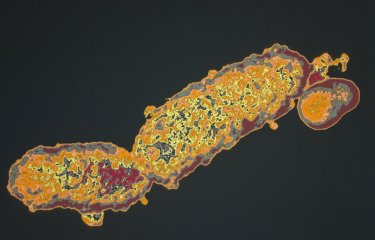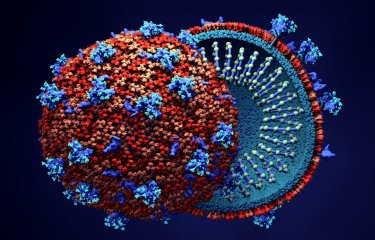Using innovative technology, scientists from the Institut Pasteur and Inserm have filmed in vivo the process by which an AIDS vaccine candidate, developed by the French Vaccine Research Institute and the ANRS, triggers the immune response. This previously unseen footage clearly shows how the vaccine recruits the immune cells needed to destroy infected cells. These results, published in the journal Nature Medicine on December 21, 2015, shed new light on the mode of action and potential of this vaccine.
In green, the cells targeted by the MVA-HIV vaccine soon activate the inflammasome (circled green spots) and die. This signal triggers a mass mobilization of immune cells. © Institut Pasteur
The aim of the study conducted by scientists from the Dynamics of Immune Responses Unit (Institut Pasteur / Inserm / VRI), directed by Inserm research director Philippe Bousso, was to observe the effect of the HIV/AIDS vaccine candidate MVA-HIV – currently undergoing clinical trials by the French Vaccine Research Institute (VRI) and the ANRS – on the immune response.
The scientists administered the vaccine to healthy mice, then observed in real time how cells from the immune system were mobilized to the lymph node, the organ where the vaccine response is developed, in just a few hours.
For the first time, using a powerful, non-invasive microscopic imaging technique, the scientists were able to watch in vivo and in real time as the vaccine induced the formation of the inflammasome, a complex assembly of proteins with a highly specific structure which appears in macrophages, the first immune cells targeted by the vaccine.
The inflammasome promotes the maturation of the chemical messenger interleukin (IL)-1 but also induces macrophage death, thereby releasing this inflammatory messenger in the lymph node. This signal triggers a chain reaction which assembles several key players of the immune system in the lymph node, including killer cells, which are vital for the vaccine response.
These in vivo films have given the scientists a detailed picture of the main stages in the mechanistic action of this vaccine and highlighted an important pathway that orchestrates the effective mobilization of the immune response. "This is the first time that the formation of this original structure, the inflammasome, has been observed in vivo and in real time," commented Philippe Bousso. "Our research demonstrates the potential of the vaccine candidate MVA-HIV to trigger a significant, diverse immune response."
This research was supported by the French Vaccine Research Institute, the French Foundation for Medical Research and the European Research Council (ERC).
Source
In vivo imaging of inflammasome activation reveals a subcapsular macrophage burst response that mobilizes innate and adaptive immunity, Nature Medicine, December 21, 2015
Pervinder Sagoo (1,2), Zacarias Garcia (1,2), Beatrice Breart (1,2), Fabrice Lemaître (1,2), David Michonneau (1,2), Matthew L. Albert (3,4), Yves Levy (5,6,7,8) and Philippe Bousso (1,2,5)
(1) Dynamics of Immune Responses Unit, Institut Pasteur, Paris, France.
(2) Institut National de la Santé et de la Recherche Médicale U668, rue du Dr Roux, Paris, France.
(3) Laboratory of Dendritic Cells Immunobiology, Institut Pasteur, Paris, France.
(4) Institut National de la Santé et de la Recherche Médicale U818, Paris, France.
(5) Vaccine Research Institute, Créteil, France.
(6) Institut National de la Santé et de la Recherche Médicale U955, Créteil, France.
(7) Faculté de Médecine, Université Paris Est, Créteil, France.
(8) Service d'immunologie clinique et maladies infectieuses, AP-HP, Hôpital H. Mondor-A. Chenevier, Créteil, France.





